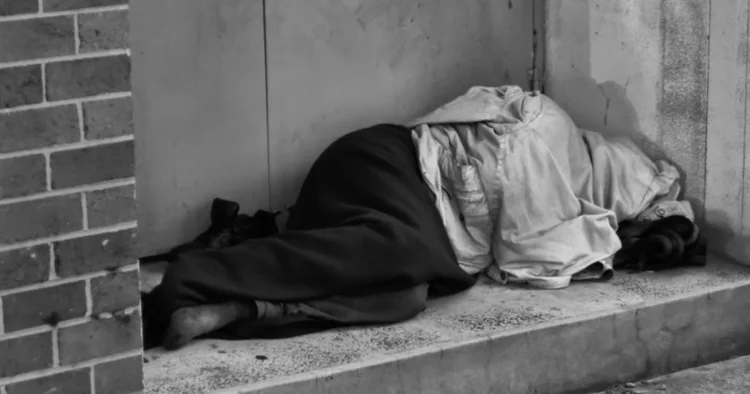Hartford, CT – Homelessness in Connecticut has surged by 13% in the past year, according to the newly released Point-in-Time (PIT) count report.
The statewide survey recorded 3,410 sheltered and unsheltered individuals experiencing homelessness, marking an increase of 395 people from 2023’s total of 3,015.
“This increase is concerning and highlights the ongoing challenges faced by individuals and families experiencing homelessness,” the report stated.
Family homelessness on the rise
The count, which was conducted last year, found that family homelessness is growing at an alarming rate.
In 2024, 362 family households were identified, comprising 1,108 people, including 677 children.
The figures represent a 16% increase from 2023’s 310 family households, which included 965 individuals and 583 children.
“The count of families with children has increased from 310 households in 2023 up to 362 households in 2024. These 362 family households are made up of 1,108 people, of which 677 were children. In 2023, these households were made up of 965 people, of which 583 were children. Across both metrics, this is an increase of about 16%,” the report stated.
Households with adults only also rose significantly.
“There were 2,246 households with adults only counted in 2024, compared to 1,997 households counted in 2023. These households were made up of 2,301 people in 2024 and 2,044 people in 2023. This is an increase of about 13% across both metrics,” the report read.
Child-only households also decreased dramatically, from four in 2023 to just one in 2024, and parenting youth households declined by 33%. The findings revealed family homelessness is still a growing concern.
“The best-performing measure for the 2024 count was with child-only households and parenting youth households. Child-only households dropped from four households of six people in 2023 down to just one household in 2024. Parenting youth households dropped by 33% from 48 households down to 32 in 2024. This was a total person count decrease of 40% from 126 people down to 76 and a total child count decrease of 38% from 68 children down to 42,” the report revealed.
Shelter beds increase, but unsheltered homelessness persists
According to the report, Connecticut continues to expand its bed inventory to accommodate the rising homeless population.
The number of Emergency Shelter (ES), Safe Haven (SH), and Transitional Housing (TH) beds increased by 5% from 3,078 in 2023 to 3,227 in 2024.
Similarly, Permanent Housing (PH) and Rapid Re-Housing (RRH) beds rose by 2%, adding 187 beds for a total of 9,868 in 2024.
“The state continues to increase its bed inventory to meet the needs of people experiencing homelessness. The number of Emergency Shelter (ES), Safe Haven (SH), and Transitional Housing (TH) beds has increased from 3,078 in 2023 to 3,227 in 2024, a total of 149 (5%) new beds. The number of Permanent Housing (PH) and Rapid Re-Housing (RRH) beds has increased from 9,681 in 2023 up to 9,868 in 2024, a total of 187 (2%) new beds,” the report elaborated.
However, the state lost 170 COVID-funded beds, dropping from 1,493 in 2023 to 1,323 in 2024, a decline of 11%.
The report noted, “There were 41 COVID-funded programs active during the 2023 count totaling 1,493 beds. These numbers dropped down to 20 COVID-funded programs with 1,323 beds for the 2024 count, a loss of 170 beds (11% drop). This is significant when you consider that the number of people experiencing unsheltered homelessness was 574 in 2024. Those 170 beds could have cut that number almost one-third.”
On the night of the count, 574 individuals were found in unsheltered conditions, such as living in cars, under bridges, or in public spaces.
Long-term homelessness trends
The report highlighted that 665 individuals counted in 2024 were also counted in 2023, while 339 had been counted in both 2022 and 2024. Among those tracked over two years, 75% found more stable housing situations, while 20% remained in emergency shelters and 5% were still unsheltered.
“For example, in 2024, there were 339 people counted who were also counted in 2022, and there were 665 people counted in 2024 who were also counted in 2023. The ‘location in 2024’ column tells us where those people were found during the 2024 count.”
Demographics: disparities persist
People of color remain disproportionately affected by homelessness in Connecticut.
The 2024 PIT count found that 68% of the state’s homeless population identified as Black, Indigenous, or People of Color (BIPOC), while only 32% identified as White.
“Below are the counts by the new race categories. We can see that those who identify as White make up 32% and those who identify as Black, Indigenous, and/or People of Color (BIPOC) make up the majority of persons experiencing homelessness at 68%,” the report revealed.
Other key demographic findings include:
“71% of all Emergency Shelter (ES) programs were participating in HMIS on the night of the count. This translates to 76% of all people counted in ES being found in an HMIS-based ES program,” the report said.
The report added, “88% of all Street Outreach (SO) programs participated in HMIS on the night of the count. This translates to 89% of all people counted in SO being found in an HMIS-based SO program.”
Looking ahead
Since 2016, Connecticut has increased its Permanent Housing and Rapid Re-Housing beds by 2,765, with a total of 3,227 emergency shelter, transitional housing, and Safe Haven beds available.
However, despite the government efforts, the PIT count continues to hover around 3,000 individuals annually.
State officials and service providers continue to push for long-term solutions, including increased funding for permanent supportive housing and expanded access to rapid rehousing programs.
“The challenge moving forward is to slow the influx of first-time homeless individuals, reduce reoccurring homelessness, and meet the complex needs of older adults, both housed and unhoused,” the report concluded.
For a full breakdown of Connecticut’s 2024 Point-in-Time Count, you may access the full report here.














